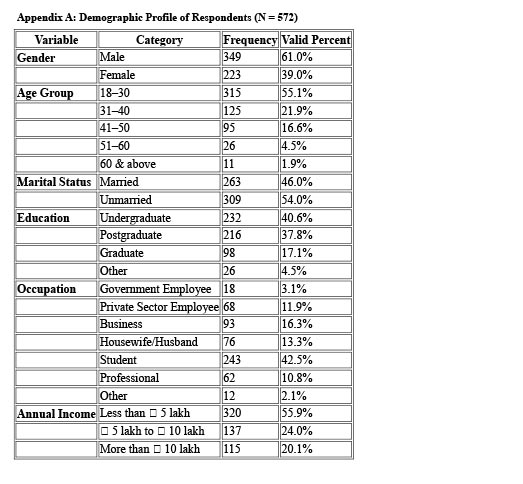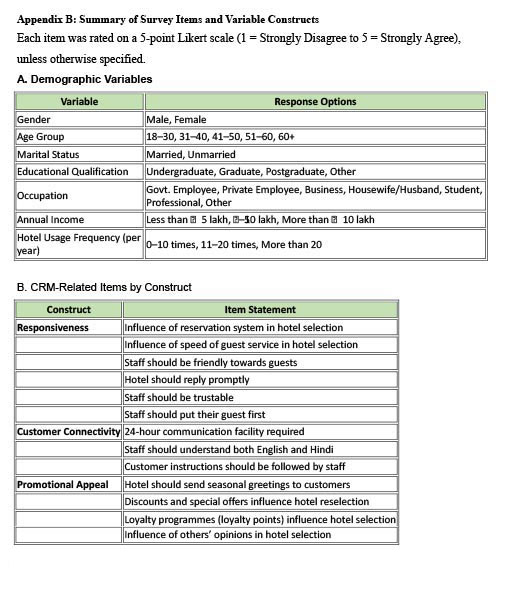Demographic Determinants of CRM Dimensions: Evidence from Indian Hospitality and the 3D-CRM Model
Newsletter
Subscribe now to get notified about IU Nagaland Journal updates!
Search
Demographic Determinants of CRM Dimensions: Evidence from Indian Hospitality and the 3D-CRM Model
Dr. Ratish C Gupta, Associate Professor, DC Business School, Chartered Marketer Chartered Institute of Marketing UKJitendra Tripathi, Vice President CDM Smith
Abstract
This study investigates how demographic variables shape customer relationship management (CRM) perceptions in the Indian hospitality sector. A structured survey of 572 hotel patrons, gathered through convenience and snowball sampling, measured three empirically derived CRM dimensions—customer connectivity, promotional appeal and responsiveness. Exploratory factor analysis confirmed the robustness of these constructs, while ANOVA with post hoc tests revealed that profession and income exert the strongest influence on all three dimensions, underscoring the heterogeneous nature of guest expectations. Building on these findings, the paper proposes the original 3D CRM Model (Demographic Driven Dimensions of CRM), which positions demographic characteristics not as passive descriptors but as active determinants of how travelers evaluate service experiences. The model highlights the strategic imperative for hospitality firms to customize CRM initiatives to distinct socio economic profiles, thereby deepening engagement and fostering long-term loyalty. In an increasingly segmented and experience led marketplace, demographic based personalization offers hotel managers a tangible route to competitive advantage.
Keywords:
Customer Relationship Management (CRM), Customer Connectivity, Demographic Influence, Hospitality Sector, Customer Engagement
Introduction
Customer Relationship Management (CRM) has emerged as a critical strategic framework in contemporary business environments, particularly for organizations operating in competitive and service-intensive sectors. At its core, CRM focuses on developing and sustaining long-term, profitable relationships with customers, thereby enhancing loyalty, improving customer retention, and generating sustained business value. Organizations with higher customer retention rates benefit from improved market segmentation, better access to quality customer data, and increased sales volumes, ultimately resulting in a stronger competitive position.
While substantial research has examined the role of CRM in sectors such as banking, telecommunications, and healthcare, its application and effectiveness within the hospitality industry—particularly in the Indian context—remain underexplored. Existing literature acknowledges the potential of CRM to enhance customer loyalty in hospitality settings, yet empirical studies focused on this sector are relatively limited (Dimitriadis & Stevens, 2008). Moreover, the evolving expectations of hotel guests and the increasing emphasis on personalized service experiences necessitate a closer examination of CRM practices tailored to hospitality consumers.A particularly under-researched dimension in this context is customer connectivity—the emotional and service-based bond that guests form with hospitality brands. While promotional strategies are widely used to attract customers, their long-term impact on loyalty is often limited without a corresponding emphasis on connectivity and engagement. This study addresses this gap by exploring how CRM-driven elements such as promotional appeal and customer connectivity influence loyalty outcomes in the Indian hospitality sector.
The research aims to determine whether CRM can serve not merely as a technological solution but as a strategic tool for building lasting customer relationships in a dynamic, experience-driven industry. By examining the demographic drivers of CRM effectiveness, the study contributes to a more nuanced understanding of consumer behaviour and offers actionable insights for hospitality managers seeking to enhance guest loyalty through personalized relationship management.
Literature Review
Theoretical Foundation of CRM in HospitalityCustomer Relationship Management (CRM) is a strategic framework for managing customer interactions and gaining a competitive advantage. Evolving from a purely technological tool, it is now seen as a holistic approach integrating people, processes, and data. Its theoretical basis stems from relationship marketing, which focuses on building long-term, mutually beneficial engagements rather than one-off transactions (Dutu & Halmajan, 2011).
Key to effective CRM is the completeness and accuracy of customer data (Brohman et al., 2003), and its integration into core hotel operations to improve strategic outcomes (Sigala, 2005). The successful implementation of CRM technology is dependent on organizational commitment, staff training, and a customer-centric culture.
CRM literature also leverages established frameworks like the Balanced Scorecard (Kaplan & Norton, 1996) and the Technology Acceptance Model (Davis, 1989). These models provide a multidimensional view, helping to evaluate CRM's impact beyond just financial metrics by considering factors like customer satisfaction, process alignment, and organizational readiness.
Empirical Review: Thematic Perspectives
1. CRM and Customer Satisfaction & Retention:
Studies consistently show that CRM initiatives improve customer satisfaction by enabling personalized service and consistent interactions (Dimitriadis & Stevens, 2008). In the hospitality sector, loyalty programs, staff responsiveness, and efficient service processes are critical drivers of guest satisfaction (Gupta & Vohra, 2019). Beyond satisfaction, CRM is also a core driver of customer retention. Scholars emphasize that service quality and emotional engagement foster long-term loyalty (Kandampully & Suhartanto, 2003). The shift from transactional to relational engagement, enabled by CRM, significantly contributes to customer lifetime value and retention, particularly in experience-driven sectors like hospitality (Wu & Li, 2011).
2. Technology Integration and Knowledge Sharing:
The effectiveness of CRM is heavily tied to technology and organizational learning. Integrated customer knowledge systems improve operational consistency (Lo et al., 2010), while cross-functional knowledge sharing ensures consistent service quality across all customer touchpoints (Fan & Ku, 2010). However, a key caution is to avoid over-reliance on automation, which can diminish the crucial human element in hospitality. Dowling (2002) advises a balanced approach where technology supports, but does not replace, personalized service.
3. Organizational Readiness and Strategic Alignment:
The success of CRM implementation hinges on internal preparedness, leadership support, cultural alignment, and system compatibility (Hung et al., 2010). This "CRM readiness" is a precondition for success (Dutu & Halmajan, 2011). In hospitality, where multiple departments are involved in service delivery, top management support and strategic integration across all functions—from the front desk to housekeeping—are vital for a seamless guest experience (Eid, 2007).
4. CRM as a Strategic Tool for Innovation:
CRM is increasingly recognized as a strategic tool for innovation and competitive advantage, not just an operational one. Customer-centric strategies help hotels adapt to dynamic market conditions (Dev & Olsen, 2000). With the integration of AI and machine learning, CRM systems can enable hyper-personalization and predictive analytics, allowing hotels to anticipate guest needs proactively. Ultimately, an organization's capacity to convert customer data into actionable insights determines its ability to innovate and stay competitive (Verdugo et al., 2009).
Summary and Research Gap
The literature consistently presents Customer Relationship Management (CRM) as a multifaceted strategy that, when implemented effectively, boosts customer satisfaction, fosters loyalty, and improves overall organizational performance in the hospitality industry.
Despite a wealth of empirical research, there are two key gaps in the current literature:
A significant need exists for context-specific studies that examine how demographic factors (age, gender, education, and income) influence CRM effectiveness, particularly within the diverse hospitality landscape of India. Few studies have explored the interplay between internal organizational readiness (such as leadership support and cultural alignment) and external customer expectations to determine CRM outcomes, especially in emerging economies.
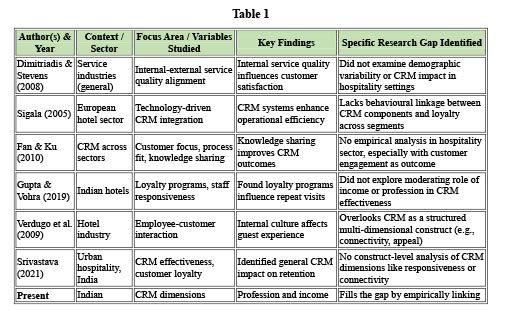

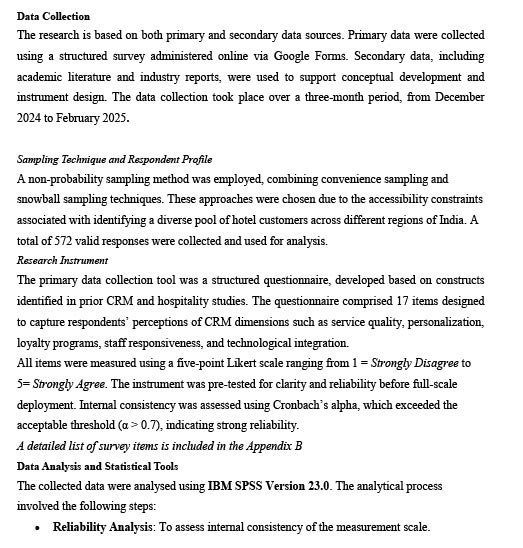
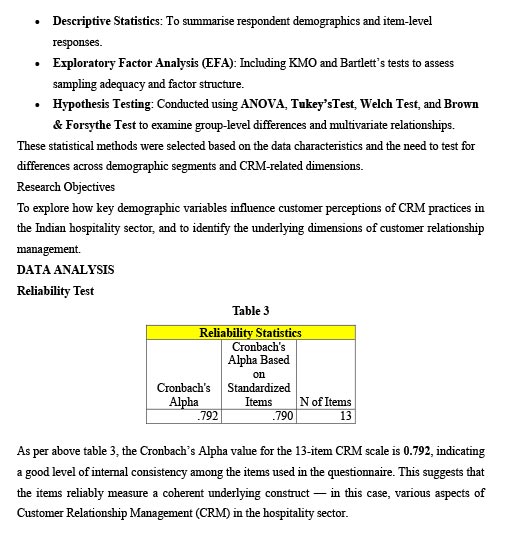
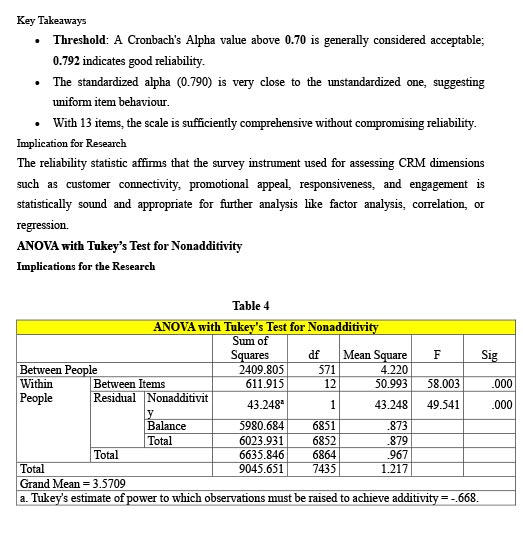
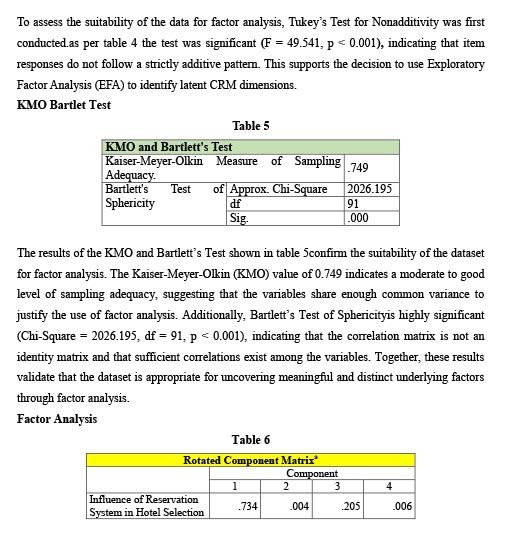

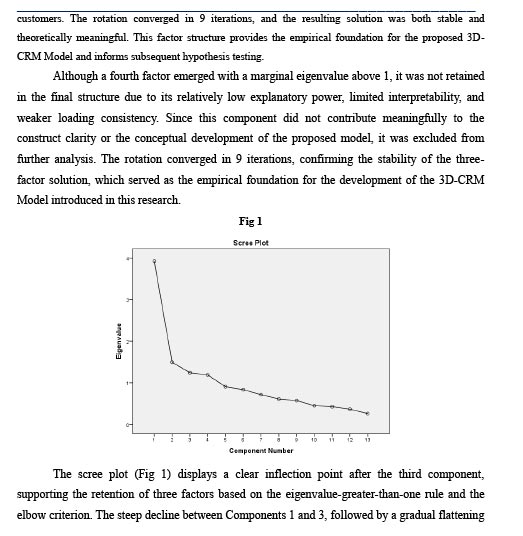
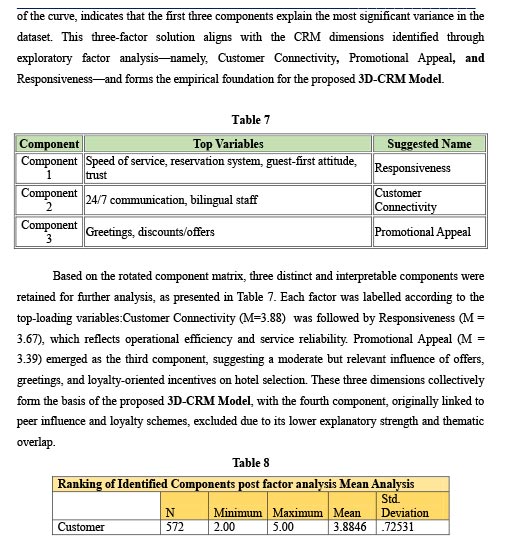


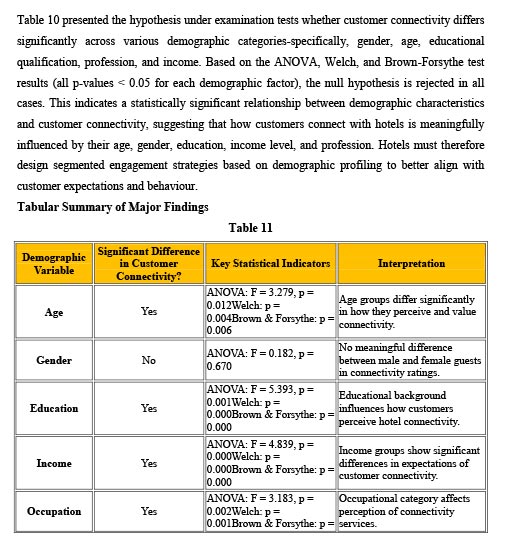
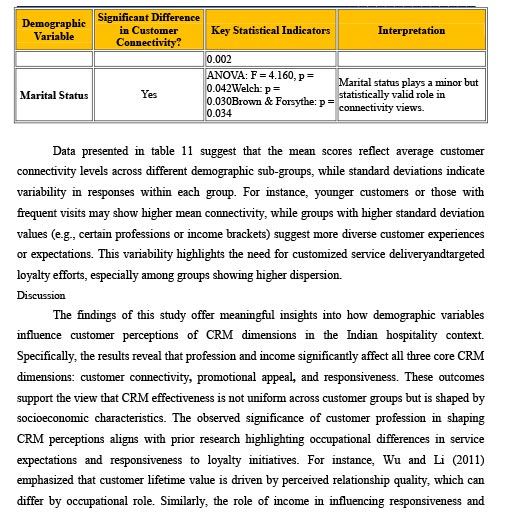
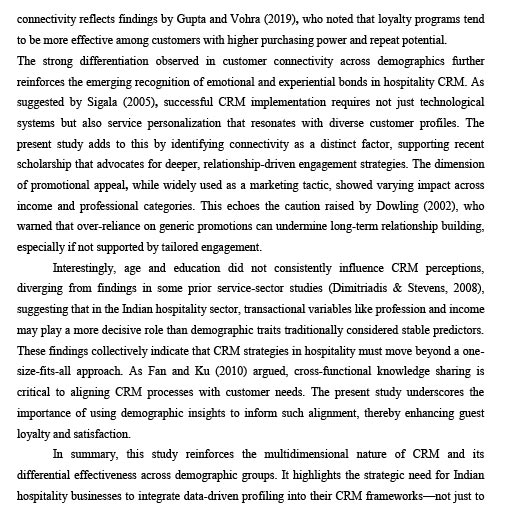
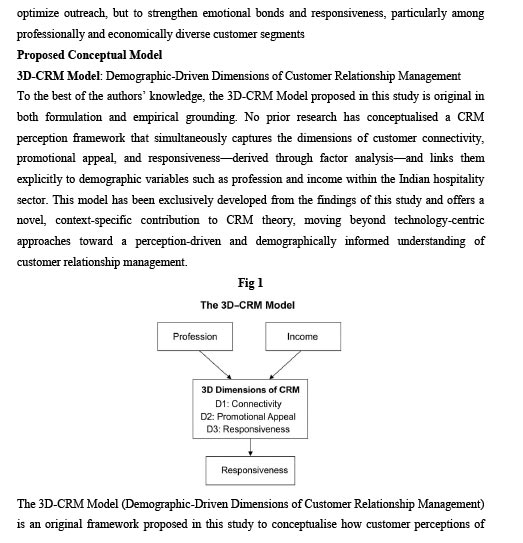
The 3D-CRM Model (Demographic-Driven Dimensions of Customer Relationship Management) is an original framework proposed in this study to conceptualise how customer perceptions of CRM practices are shaped by demographic profiles within the Indian hospitality context. Derived through exploratory factor analysis, the model identifies three key dimensions of CRM as experienced by customers: customer connectivity, promotional appeal, and responsiveness. These dimensions reflect how individuals engage with service quality, communication, staff interactions, and loyalty initiatives.Among these, customer connectivity was found to be significantly influenced by demographic variables—specifically profession and income—suggesting that emotional and communicative ties with hospitality brands are shaped by socio-economic background. Although promotional appeal and responsiveness did not exhibit significant variation across demographics in this dataset, they remain theoretically relevant and empirically validated CRM constructs. The 3D-CRM Model offers a structured understanding of CRM perception, moving beyond a technology-led view to a more customer-centric and demographically informed perspective. It provides a basis for both strategic CRM customisation in practice and future empirical research aimed at uncovering behavioural outcomes such as customer loyalty and satisfaction. This model also opens avenues for further exploration of each CRM dimension as an independent driver of service effectiveness.
Conclusion
This study investigated how key demographic factors-gender, age, education, profession, and income-relate to three core customer experience dimensions: connectivity, responsiveness, and engagement. The findings confirm that demographics significantly shape how customers perceive and interact with service-oriented businesses.
Of all the variables, profession and income proved to be the most influential, consistently affecting perceptions across all three dimensions. The research's most significant contribution is the development of the 3D-CRM Model, a new framework that empirically links customer perceptions of CRM with specific demographic characteristics within the Indian hospitality sector. This model is a valuable tool for creating more personalized and inclusive CRM strategies in experience-driven industries.
In summary, the results show that demographics are not just static descriptors; they are active drivers of customer behaviour, expectations, and loyalty. By understanding and responding to these differences, hospitality businesses can build stronger customer relationships, boost engagement, and improve long-term retention.
Managerial Implications Based on the 3D-CRM Model
- Adopt a Demographic-Sensitive CRM Strategy -The 3D-CRM Model highlights the influence of profession and income on CRM perception. Hospitality organisations should develop segmented CRM strategies, customising service experiences and loyalty offerings to align with the socio-economic profiles of their target customers.
- Enhance Connectivity Through Tailored Communication - Since customer connectivity is significantly shaped by demographic profiles, especially profession, personalised communication strategies—via email, in-app messaging, or staff interactions—should be adapted to the needs, preferences, and communication styles of different customer groups.
- Invest in CRM Analytics for Profile-Based Engagement - Integrating customer analytics tools that go beyond surface-level demographics can improve real-time responsiveness. This includes tracking behavioural trends across income groups and professions to optimise service delivery and campaign targeting.
- Train Staff to Engage by Profile, Not Just Protocol - Responsiveness and frontline interaction should be guided by an understanding of demographic cues. Training customer-facing staff to identify and respond to varying expectations across professional or income groups can improve service satisfaction and perceived CRM value.
Future Scope of Research
- Incorporate Psychographic and Behavioural Dimensions -Building on the 3D-CRM framework, future studies could integrate psychographic traits (e.g., lifestyle, digital habits, personality) to better predict how different customer profiles interpret CRM efforts.
- Test the 3D-CRM Model Across Industries -While developed within the Indian hospitality context, the 3D-CRM Model could be tested and refined in other service sectors like retail, healthcare, or fintech to assess its generalisability and adaptability.
- Use Longitudinal and Behavioural Tracking -A longitudinal study design could reveal how the impact of demographics on CRM perceptions evolves over time—particularly in response to technological adoption, post-COVID behaviours, or generational shifts.
- Explore CRM Technology Interfaces Across Demographics - Future research may examine how CRM touchpoints such as chatbots, apps, websites, or self-service kiosks interact with profession- and income-based customer profiles, particularly in shaping perceived responsiveness and connectivity.
Limitations of the Study
- Demographic Constraints: The study is limited to primary demographic variables and does not account for psychographic or attitudinal factors, which could further influence customer behaviour.
- Geographical or Contextual Bias: If the data was collected from a specific region or market segment, the findings may not be fully generalizable to a broader population.
- Cross-Sectional Design: Being a snapshot in time, the study doesn't capture how customer connectivity, engagement, or responsiveness change over time or due to specific interventions.
- Self-Reported Data: Responses are based on perception, which may carry social desirability bias or subjectivity, possibly influencing the accuracy of measured associations.
- Abdullateef, A. O., Mokhtar, S. S., & Yusoff, R. Z. (2010). The impact of CRM dimensions on call center performance. International Journal of Computer Science and Network Security, 10(12), 184–195.
- Brohman, M. K., Richard, T. W., Piccoli, G., & Parasuraman, A. (2003). Data completeness: A key to effective net-based customer service systems. Communications of the ACM, 46(6), 47–51.
- Dev, C. S., & Olsen, M. (2000). Marketing challenges for the next decade. Cornell Hotel and Restaurant Administration Quarterly, 41(1), 41–47.
- Dimitriadis, S., & Stevens, E. (2008). Integrated customer relationship management for service activities: An internal/external gap model. Managing Service Quality: An International Journal, 18(5), 496–511.
- Dowling, G. (2002). Customer relationship management: In B2C markets, often less is more. California Management Review, 44(3), 87–104.
- Dutu, C., &Halmajan, H. (2011). The effect of organizational readiness on CRM and business performance. International Journal of Computers, 1(2), 106–114.
- Eid, R. (2007). Towards a successful CRM implementation in banks: An integrated model. The Service Industries Journal, 27(8), 1021–1039.
- Fan, Y., & Ku, E. (2010). Customer focus, service process fit and customer relationship management profitability: The effect of knowledge sharing. The Service Industries Journal, 30(2), 203–222.
- Hung, Y. S., Hung, H. W., Tsai, A. C., & Jiang, C. S. (2010). Critical factors of hospital adoption on CRM system: Organizational and information system perspective. Decision Support Systems, 48, 592–603.
- Lo, A. S., Stalcup, L. D., & Lee, A. (2010). Customer relationship management for hotels in Hong Kong. International Journal of Contemporary Hospitality Management, 22(2), 139–159.
- Mylonakis, J. (2009). Customer relationship management functions: A survey of Greek bank customer satisfaction perceptions. The Icfai University Journal of Bank Management, 8(2), 7–31.
- Papastathopoulou, P., Avlonitis, G., & Panagopoulos, N. G. (2007). Intra-organizational information and communication technology diffusion: Implications for industrial sellers and buyers. Industrial Marketing Management, 36(3), 322–336.
- Sigala, M. (2005). Integrating customer relationship management in hotel operations: Managerial and operational implications. International Journal of Hospitality Management, 24(3), 391–413.
- Verdugo, C. M., Oviedo-García, M. A., & Roldán, J. L. (2009). The employee-customer relationship quality: Antecedents and consequences in the hotel industry. International Journal of Contemporary Hospitality Management, 21(3), 251–274.
- Wu, S., & Li, P. (2011). The relationships between CRM, RQ and CLV based on different hotel preferences. International Journal of Hospitality Management, 30, 262–271.
